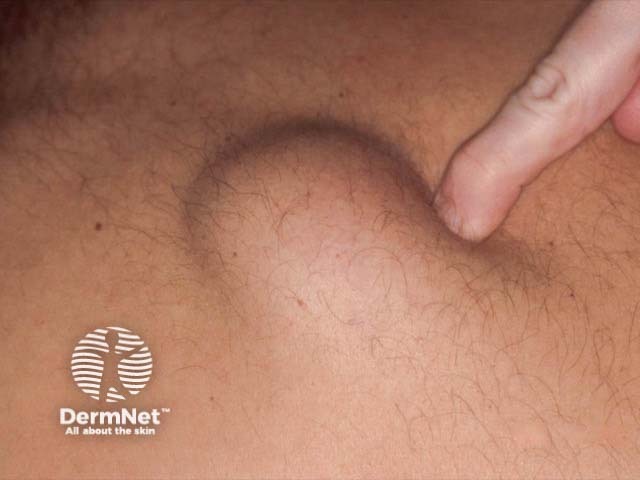Main menu
Common skin conditions

NEWS
Join DermNet PRO
Read more
Quick links
Lipoma — extra information
Lipoma
Last Reviewed: October, 2024
Author(s): Dr Rebecca Shackle, Concord Repatriation General Hospital, Sydney, Australia (2024)
Previous contributors: Vanessa Ngan, Staff Writer (2003)
Peer reviewer: Dr James A. Ida, Dermatologist, Veterans Administration, USA (2024)
Reviewing dermatologist: Dr Ian Coulson.
Edited by the DermNet content department
Introduction
Demographics
Causes
Clinical features
Variation in skin types
Complications
Diagnosis
Differential diagnoses
Treatment
Prevention
Outcome
What is lipoma?
A lipoma is a very common benign, slow-growing tumour of mature adipocytes (fat cells), which grows slowly under the skin in the subcutaneous tissue; rarely, it may expand deep to the fascia or intramuscularly. Single or multiple lesions may occur. Although lipomas may occur anywhere on the body, they most commonly are found on the trunk and upper extremities.

A lipoma on the shoulder

A large lipoma on the neck (LA-patient5)

A typical lipoma on the back

A large forehead lipoma - in this situation they are often subgaleal (LA-patient2)
Click here for more lipoma images
Who gets lipoma?
While lipomas typically affect patients between 40 and 60 years of age, they can occur at any age and are more common in patients with hyperlipidaemia, type 2 diabetes mellitus, and obesity. Both sexes are equally affected.
What causes lipoma?
The cause of lipomas is unknown. One hypothesis posits that they occur at sites of trauma as a result of the release of cytokines which cause preadipocyte differentiation and maturation.
What are the clinical features of lipoma?
Lipomas typically present as solitary, painless, soft or rubbery, often lobulated nodules, ranging from 1 to >10 cm in diameter. The overlying epidermis is unchanged and not tethered to the lesion. While most lipomas are solitary, some 5-10% of patients will have multiple lesions, usually associated with an underlying syndrome or genetic disorder (e.g., familial multiple lipomatosis, Proteus syndrome, PTEN hamartoma syndrome, Gardner syndrome, or multiple endocrine neoplasia type 2B). In the case of angiolipomas, pain is a frequent feature. Multiple painful lesions may be seen in Dercum disease.
How do clinical features vary in differing types of skin?
Clinical features do not differ across skin tones.
What are the complications of lipoma?
Rarely, large lipomas may compress nerves or other adjacent structures, leading to pain, numbness, or other symptoms.
How is lipoma diagnosed?
Lipomas are usually diagnosed clinically. Imaging and/or biopsy may be considered if there is diagnostic uncertainty.
For more information, see lipoma pathology.
What is the differential diagnosis for lipoma?
- Epidermoid cyst
- Hibernoma
- Liposarcoma
- Angiolipoma
- Angiomyolipoma
- Ganglion cyst
- Madelung disease
What is the treatment for lipoma?
General measures
Lipomas do not require treatment except if they are impinging on adjacent structures and causing symptoms. Most commonly, if they are treated, it is due to cosmetic concern.
Specific measures
Surgical excision is curative, provided the thin capsule is completely removed. Larger lipomas, or those associated with multiple lipomatosis for example, can be treated with liposuction. Laser lipolysis is also an effective treatment.
Liposuction or laser are associated with improved cosmetic outcomes compared with that of excision. However, they also have a significantly higher recurrence rate as the lipoma capsule is not completely removed.
How do you prevent lipoma?
There are no well-established modifiable risk factors for lipoma.
What is the outcome for lipoma?
Local recurrence is rare with excision and malignant transformation is exceedingly rare.
Bibliography
- Kolb L, Yarrarapu SNS, Ameer MA, Rosario-Collazo JA. Lipoma. PubMed. Published 2020. Journal
- Lindberg MR, Lucas D, Cassarino DS, Gardner JM, Stallings-Archer K. Diagnostic Pathology: Soft Tissue Tumors. Editorial: Philadelphia, Pa. Elsevier; 2016.
- Piccolo D, Mohammed Hussein Mutlag, Pieri L, et al. Lipoma management with a minimally invasive 1,444 nm Nd:YAG laser technique. Frontiers in Medicine. 2022;9. doi:10.3389/fmed.2022.1011468. Journal
